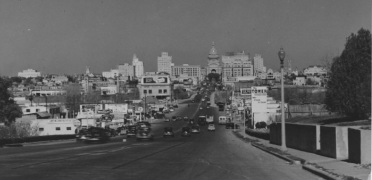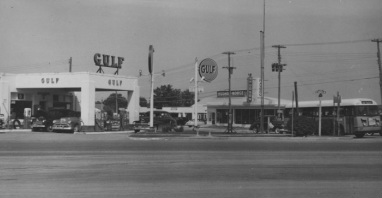South Congress: a case study
|
Just a few miles south of the Texas State Capital Building on Congress Avenue, lays the most culturally dense area in Austin. This neighborhood is known as South Congress, or SoCo. Here, one will find a plentitude of small shops, musical performances, bars, restaurants, and interesting people. SoCo has not always been like this, however.
In its earliest years (during the 1920s and 30s), the town boomed from the increased popularity of the automobile.[1] The level of traffic that regularly flowed through South Congress can be seen in Figure 1. The South Congress area was developed by merchants who wanted to attract those travelers who were using the main road, Congress Avenue, to get to San Antonio (see Figure 2). This sustained many successful businesses until the early 1960s when Interstate 35 was completed.[3] This more efficient route to San Antonio left SoCo in shambles as their main source of income ceased to pass through. |
 Figure 3: Magnolia Cafe South Sign 2011.[6]
Figure 3: Magnolia Cafe South Sign 2011.[6]
In the years that followed, South Congress turned into the part of Austin where typically only drug dealers and prostitutes walked the streets.[1] It remained like this until the late 1980s when a few merchants opened up shop in SoCo. Of the first of these private revitalization efforts, Magnolia Café South did particularly well because its owners, Kent Cole and Diana Prechter, decided to keep it open 24 hours a day.[1] They were able to do this because the city imposed very few regulations on the older satellite communities like SoCo. This attracted enough of Austin’s “late-night crowd” (much of which existed due to the University of Texas at Austin) to sustain a restaurant in an area which had received very little commerce from Austin proper over the last twenty years. This early success spread quickly as more and more people began buying and renovating old store fronts that had existed there since the 1930s.
|
In the early 1990s, Austin experienced an influx of educated immigrants who came to work for newly founded tech start-ups such as Dell and Sematech.[2] This spike in population in a city that was not ready to house and support so many people led many to look just outside the city’s center for housing options. One of these areas was South Congress. The new shops, such as Magnolia Café South, acted as catalysts for renovations in this historic part of town. The arrival of young, middle class, educated people helped build the SoCo that exists today. There was no city planning that went on to make this happen, and even when planners suggested improvements in the late 1990s, residents refused.[1] They wanted to keep the small-town feel of SoCo that made it so unique. In 2005, neighborhood plans were approved to help maintain this character by encouraging pedestrian and bike traffic and discouraging large retail chains from being built in Soco as well as in surrounding areas (see Figure 4).[3]
|
- Patoski, Joe N. "National Trust for Historic Preservation." Preservationnation.org. Preservation Magazine, July-Aug. 2010. Web. 20 Aug. 2014. <http://www.preservationnation.org/magazine/2010/july-august/austin-tx.html>.
- Walsh, Bryan. "Red State, Green City: How Austin Has Become America's Clean-Tech Hub." Time. Time Inc., 16 Jan. 2012. Web. 20 Aug. 2014. <http://content.time.com/time/magazine/article/0,9171,2103780,00.html>.
- Koenig, Alex, Mark Walters, and Kathleen Welder. South Congress Combined Neighborhood Plan. Rep. Austin: City Council, 2005. Web. <ftp://ftp.ci.austin.tx.us/npzd/Austingo/scongress-np.pdf>.
- [South Congress Avenue looking north], Photograph, January 14, 1948; digital image, (http://texashistory.unt.edu/ark:/67531/metapth125317/ : accessed September 02, 2014), University of North Texas Libraries, The Portal to Texas History, http://texashistory.unt.edu; crediting Austin History Center, Austin Public Library, Austin, Texas.
- [Corner of South Congress and Riverside], Photograph, n.d.; digital image, (http://texashistory.unt.edu/ark:/67531/metapth125327/ : accessed September 02, 2014), University of North Texas Libraries, The Portal to Texas History, http://texashistory.unt.edu; crediting Austin History Center, Austin Public Library, Austin, Texas.
- Magnolia Cafe South. Digital image. Flatfinders. Wordpress, 30 Sept. 2011. Web. 28 Aug. 2014. <http://flatfinders.wordpress.com/2011/09/30/helping-the-locals-get-a-nice-spot-todays-menuchef-from-magnolia-cafe/>
- Breal, Jordan. South Congress sidewalk. Digital image. Texas Monthly. N.p., 19 July 2013. Web. 1 Sept. 2014. <http://www.texasmonthly.com/wanderer/ask-wanderer-south-congress-and-beyond>.



